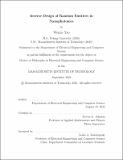Inverse Design of Random Emitters in Nanophotonics
Author(s)
Yao, Wenjie
DownloadThesis PDF (11.84Mb)
Advisor
Johnson, Steven G.
Terms of use
Metadata
Show full item recordAbstract
Incoherent light from random emitters, such as thermal radiation, are very common in nature. However, modeling such random emitters may be challenging, as it naively requires Maxwell’s equations to be solved for all emitters to obtain the total response, which becomes computationally intractable in conjunction with large-scale optimization (inverse design). In this work, we present a trace formulation of random emitters that can be efficiently combined with inverse design, even for topology optimization over thousands of design degrees of freedom.
We begin with a trivial case where the emitter is at a single location with random orientations, which leads to compute the local density of states (LDOS). In a previous work, a shape-independent upper limit was derived for LDOS, but simple geometries such as bowtie are 2-3 orders of magnitude away from this limit. By computational optimization of air-void cavities in metallic substrates, we show that the LDOS can reach within a factor of ≈ 10 of the upper limits, and within a factor ≈ 4 for the single-polarization LDOS, demonstrating that the theoretical limits are nearly attainable.
We then study the more general case where emitters are distributed randomly in space. We present several examples of incoherent-emission topology optimization (TopOpt), including tailoring the geometry of fluorescent particles, a periodically
emitting surface, and a structure emitting into a waveguide mode.
Finally, we employ our trace formulation for inverse design of nanopatterned surfaces that maximize spatially averaged surface-enhanced Raman (SERS) spectra from molecules distributed randomly throughout a material or fluid. This leads to radically different designs than optimizing SERS emission at a single known location, as we illustrate using several 2D design problems addressing effects of hot-spot density, angular selectivity, and nonlinear damage. We obtain optimized structures that perform about 4× better than coating with optimized spheres or bowtie structures and about 20× better when the nonlinear damage effects are included.
Date issued
2022-09Department
Massachusetts Institute of Technology. Department of Electrical Engineering and Computer SciencePublisher
Massachusetts Institute of Technology